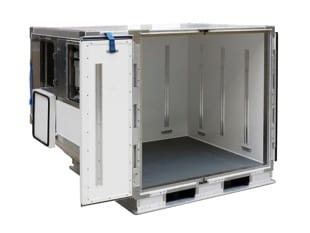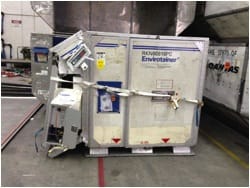Cargo Terminals, Freight Forwarders, CARE, Ground Handlers, Special Cargo ULD
Temperature Controlled Containers (TCC’s)
The movement of temperature-sensitive healthcare products by air has undergone an amazing growth in the past few years.
Airlines now offer a proliferation of different offerings for the movement of various healthcare products under various temperature controlled environments. The subject of Pharma is never far from the industries eye, being talked about in conferences and written about in the trade press.
This is an exciting and potentially profitable new sector in an industry that struggles to be profitable but, as airlines rush headlong into this new territory, how much consideration is being given to the ULD aspect of this new activity.
Setting the scene, this quotation from the UK MHRA (Medicines and Healthcare Products Regulatory Agency) summarizes the underlying issues:

*GMP/GDP: Good Manufacturing Practices / Good Distribution Practice
Anyone familiar with the air cargo industry would probably agree with this concern. Shipments of pharmaceuticals worth large amounts of money and requiring very precise temperature control may well be moved using infrastructure and operating practices that are in many cases less than satisfactory. Add to the challenge of moving these products enormous distances through multiple different operating environments and it becomes clear that achieving consistently acceptable outcomes for temperature-sensitive healthcare product shipments is not something to be undertaken lightly.
The history of the movement of temperature-sensitive perishables by air is quite interesting. The advent of wide-body aircraft and ULD in the early 70s made this possible and the first units were no more than a ULD incorporating insulation on all surfaces. Used either with or without dry ice, these early insulated ULD were used mainly for transporting foodstuffs, with limited applications in other products such as high-end film and blood plasma.
As the products steadily became more sophisticated adding dry ice bunkers and air circulation fans, the range of products that could be carried also increased, allowing the transportation of high-end food products and also non-food products.
Furthermore in recent years, we have seen the introduction of the most sophisticated Temperature Control Containers yet, incorporating large rechargeable battery systems driving heating/cooling systems that, regardless of the external environment, can maintain a specific temperature range over a long period of time. So, on one hand there have been enormous changes in the requirements and on the other hand, enormous changes in the technologies available. Unfortunately, as pointed out in the quotation at the start of this article, the operating environment in which this activity is carried on remains at best marginal and at worst seriously deficient when it comes to handling shipments of this nature.
The concerns can be broken down into 2 main areas:
- The value and vulnerability of the shipments
- The cost and complexity of the ULD equipment
Taking these one by one:
Temperature-sensitive healthcare have certain unique characteristics:
- Should a temperature excursion occur during transit, exposing the shipment to higher or lower temperatures than permitted, it is possible that the chemical composition of the item will have been affected without any visual evidence. Soft fruit for instance will quickly show signs of having been overheated but pharmaceuticals may show no external evidence and yet, their capability may have been seriously compromised, putting the patient’s health at risk.
- Pharmaceutical shipments may be of extremely high value, creating a substantial commercial risk in case of loss.
ULD used to transport temperature-sensitive healthcare products are very different from standard ULD:
- The top of the range TCC’s use today employ sophisticated energy management, cooling and heating, safety and control systems, in addition of course to employing extremely high grade insulation. These characteristics drive a strong requirement for careful and skilled operations at all time.
- TCC’s may be worth many many times the value of the standard ULD and damage through mishandling of this equipment is always going to result in extremely costly repairs.
Add up these 4 unique characteristics associated with this particular segment of air cargo and it becomes clear that temperature-sensitive healthcare transport operations should not be undertaken lightly. ULD CARE would suggest that any organization either already carrying out such operations or considering carrying out such operations should place as a high priority the importance of establishing a strong set of core competencies in this area at the earliest opportunity. Without proper knowledge of the complexities of this activity the chances of costly and potentially dangerous failures will be increased very significantly.
This article is just an introduction to this complex subject and in future newsletters we will explore it in more detail.
 |
 |
|
|
A modern temperature controlled container. |
Results of inexperienced or uninformed TCC operations. Damage that severe could require repair costs in excess of US $20,000, or even a total write-off. |


